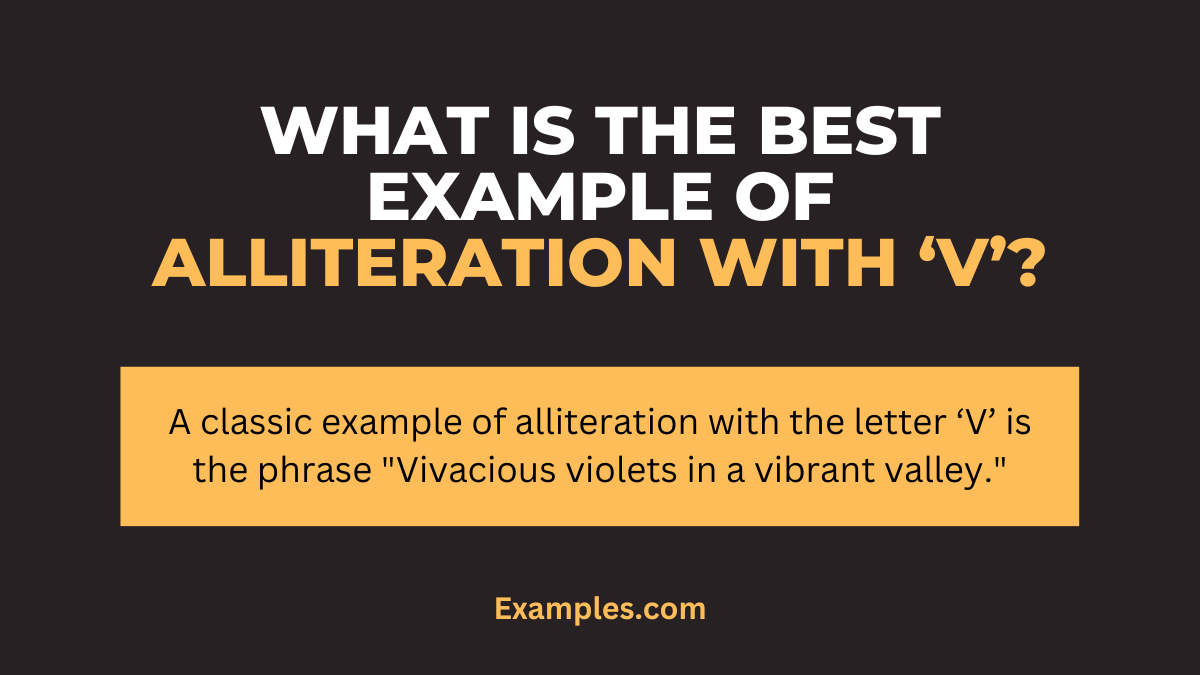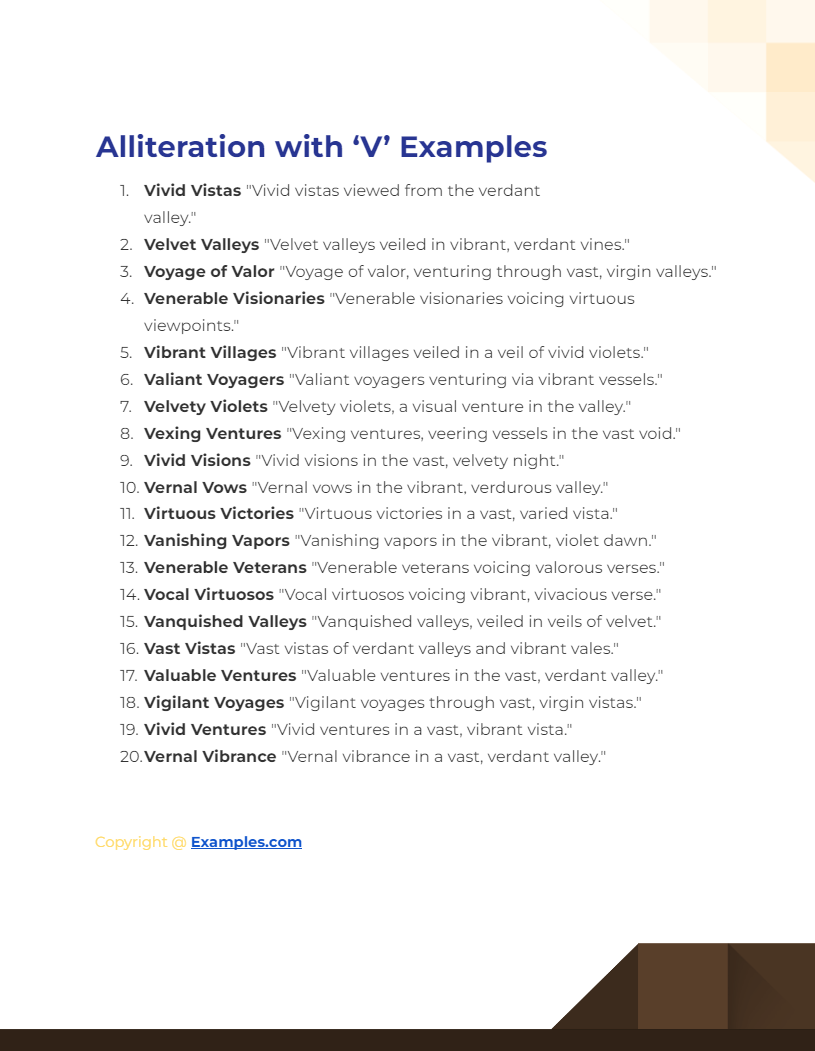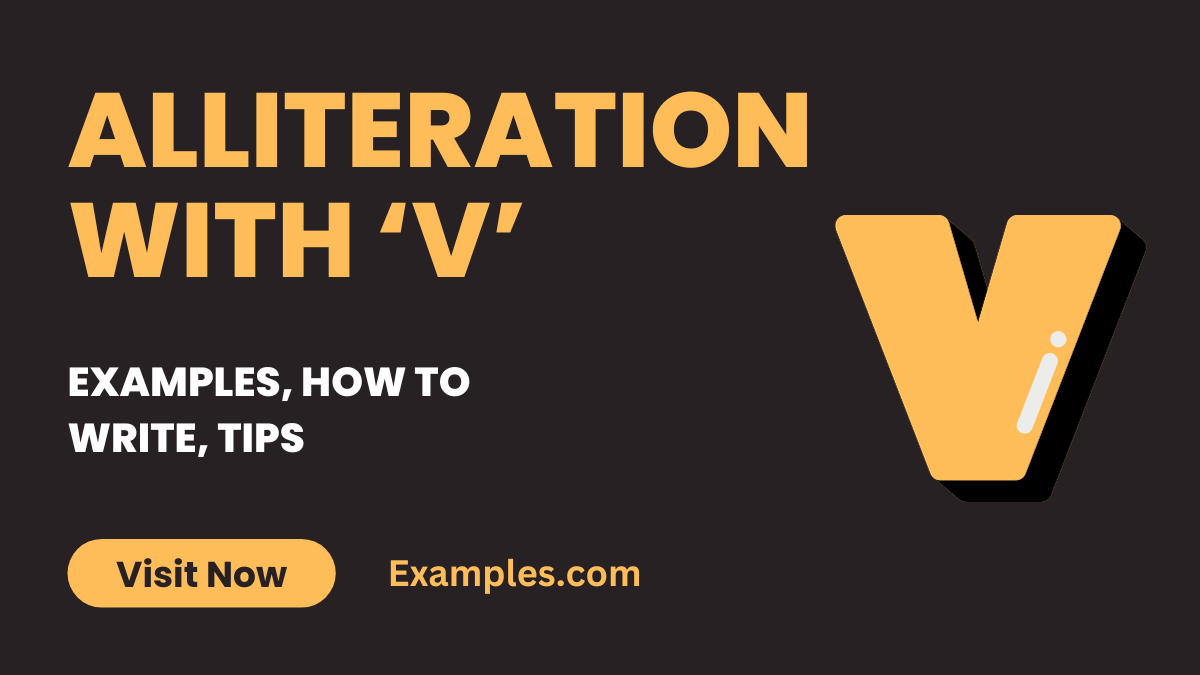19+ Alliteration with V Examples
Alliteration with the letter ‘V’ veers towards a vivid and vibrant effect in literary compositions. This specific form of alliteration involves the repetition of the ‘V’ sound at the beginning of words in a sentence or a phrase. It’s a stylistic approach that can vivify and add a particular verve to writing, be it poetry, prose, or even persuasive texts. The ‘V’ sound, with its vibrant and vivacious tone, can inject energy and emphasis, making the text more engaging and memorable. Utilizing famous alliterations with ‘V’ effectively can be a valuable tool for writers seeking to captivate their readers’ attention and convey their message with a more vigorous and lively tone.
Download Alliteration with 'V' Examples
Download Alliteration with 'A' to 'Z' Examples
What is the Best Example of Alliteration with ‘V’?

Example: A classic example of alliteration with the letter ‘V’ is the phrase “Vivacious violets in a vibrant valley.”
Meaning: Alliteration is a literary device where consecutive words in a sentence or phrase begin with the same consonant sound. In the example “Vivacious violets in a vibrant valley,” the consonant ‘V’ is repeated at the beginning of several words, creating a pleasing and rhythmic sound pattern. Alliteration is often used in literature and poetry to add emphasis, rhythm, and musicality to the text. In this specific example, the easy alliteration repeated ‘V’ sound adds a sense of liveliness and energy to the description of the violets in the valley, making the imagery more vivid and memorable.
20 Alliteration with ‘V’ Examples

Download Alliteration with 'V' Examples in PDF
Alliteration with the letter ‘V’ embarks on a vivacious voyage of vibrant and vivid verses, crafting a visual and often vigorous auditory experience. The ‘V’ sound, known for its vitality and sometimes velvety quality, is adept at creating hard alliteration examples. Particularly effective in alliteration in rhymes, the ‘V’ sound adds a dynamic and engaging dimension to verses. Here are 20 unique examples of alliteration with ‘V’, each accompanied by a rhyme title that captures the essence of the phrase.
- Vivid Vistas “Vivid vistas viewed from the verdant valley.”
- Velvet Valleys “Velvet valleys veiled in vibrant, verdant vines.”
- Voyage of Valor “Voyage of valor, venturing through vast, virgin valleys.”
- Venerable Visionaries “Venerable visionaries voicing virtuous viewpoints.”
- Vibrant Villages “Vibrant villages veiled in a veil of vivid violets.”
- Valiant Voyagers “Valiant voyagers venturing via vibrant vessels.”
- Velvety Violets “Velvety violets, a visual venture in the valley.”
- Vexing Ventures “Vexing ventures, veering vessels in the vast void.”
- Vivid Visions “Vivid visions in the vast, velvety night.”
- Vernal Vows “Vernal vows in the vibrant, verdurous valley.”
- Virtuous Victories “Virtuous victories in a vast, varied vista.”
- Vanishing Vapors “Vanishing vapors in the vibrant, violet dawn.”
- Venerable Veterans “Venerable veterans voicing valorous verses.”
- Vocal Virtuosos “Vocal virtuosos voicing vibrant, vivacious verse.”
- Vanquished Valleys “Vanquished valleys, veiled in veils of velvet.”
- Vast Vistas “Vast vistas of verdant valleys and vibrant vales.”
- Valuable Ventures “Valuable ventures in the vast, verdant valley.”
- Vigilant Voyages “Vigilant voyages through vast, virgin vistas.”
- Vivid Ventures “Vivid ventures in a vast, vibrant vista.”
- Vernal Vibrance “Vernal vibrance in a vast, verdant valley.”
Alliteration Sentence Examples with ‘V’
Alliteration sentence examples with ‘V’ often create a vivid and vibrant effect, using the ‘V’ sound to enhance the narrative with a lively rhythm. This type of alliteration is used in various literary forms, including alliteration in poems, songs, and movies, where it adds a distinct character to the storytelling. Here are three examples:
- “Vera’s vivid velvet vest vanished in the vast vineyard.”
- “Victor’s valiant venture vanquished the villainous vampire.”
- “Violet’s voice vibrated with vigor during the vocal recital.”
Alliteration Examples with ‘V’ Words
Alliteration examples using ‘V’ words demonstrate the effectiveness of this consonant in creating strong, memorable phrases. Commonly used in alliteration in songs, the ‘V’ sound adds a powerful and engaging element. Here are three examples:
- “Valuable vases vanished from the vibrant villa.”
- “The vigilant vulture viewed the valley from a vast vantage point.”
- “Vivid visions of vast valleys veiled in mist visited him at night.”
Alliteration Poems with ‘V’
An alliteration poem with ‘V’ employs the repetitive ‘V’ sound to create a rhythmically and aesthetically engaging poetic experience. Alliteration in poems, especially with the ‘V’ sound, brings a unique lyrical quality. Here are three examples:
- “Velvet veils of violet, / Vast valleys below, so quiet.”
- “Vivid vistas, views so grand, / Vastly spread across the land.”
- “Valleys of velvet green, / Very serene, a dreamlike scene.”
Alliteration Starting with ‘V’
Alliteration beginning with ‘V’ sets a specific tone and rhythm in a phrase, often creating a memorable and impactful auditory experience. Found in various artistic expressions, including alliteration in movies, it adds a distinctive flair. Here are three examples:
- “Vera’s violin voiced a vibrant, velvety melody.”
- “The vivacious vampire ventured through the vivid valley.”
- “Val’s vintage van veered around the verdant valley.”
Alliteration Adjectives with ‘V’
Alliteration with adjectives starting with ‘V’ enhances descriptions, adding depth and vividness to the imagery. This form is particularly effective in literary works where detailed characterization or setting descriptions are essential. Here are three examples:
- “The vacant, vast villa echoed with vague, vanishing voices.”
- “Vibrant, vivacious violets added vitality to the vase.”
- “Her valiant, victorious attitude was visibly inspiring.”
How to Write Alliteration with ‘V’?
Creating alliteration with the letter ‘V’ involves using words that start with the ‘V’ sound in close proximity within your sentences or phrases. The ‘V’ sound, known for its vivacity and clarity, can add a vibrant and often vigorous rhythm to your writing. This technique is used in various contexts, including educational materials for first graders and in more complex alliteration in figurative language compositions. Here’s how to craft effective alliteration with ‘V’:
- Understand the ‘V’ Sound: Familiarize yourself with the ‘V’ sound, a consonant that can bring energy and emphasis to your writing.
- Select a Theme or Concept: Choose a theme or subject that can be effectively described with ‘V’ words. This helps in finding relevant words that fit your topic, whether you’re crafting alliteration with answers or for creative expression.
- Brainstorm ‘V’ Words: Make a list of words beginning with ‘V’. Try to include a mix of nouns, verbs, and adjectives to add variety to your alliteration.
- Formulate Your Phrase or Sentence: Arrange the ‘V’ words to form a coherent and rhythmic sentence. Aim for a natural flow that highlights the alliterative effect.
- Read Aloud for Rhythm: The effectiveness of alliteration is often best judged audibly. Read your sentence aloud to ensure it has a pleasing rhythm.
- Revise for Clarity and Impact: Make sure your alliterative phrase is clear and contributes effectively to your overall message or story.
- Apply in Various Contexts: Whether it’s in alliteration figurative language exercises, as part of teaching alliteration for first grade, or in creative writing, adapt your use of ‘V’ alliteration to suit the purpose and audience.
Tips for Using Alliteration with ‘V’
Here are the Tips for Using Alliteration with ‘V’:
- Use Sparingly: Alliteration with ‘V’ can be very effective, but overusing it can make your text feel forced. Use it to emphasize key points or add stylistic flair in moderation.
- Maintain Clarity: Your primary goal is to convey a message clearly. The alliteration should not confuse the reader but rather enhance the understanding.
- Vary Word Length and Complexity: Mix short and long ‘V’ words, as well as simple and complex ones, for a more dynamic textual rhythm. This is particularly important in alliteration for first grade, where simpler language is essential.
- Consider the Mood: The ‘V’ sound can be vibrant and lively. Use it in contexts where this mood is desired.
- Read and Revise: Reading your work aloud helps you assess the rhythm and flow. Adjust as needed to ensure the alliteration enhances the text.
- Appropriate for Audience: Tailor your alliteration to your audience. For example, alliteration for first grade should be simpler and more playful than alliteration for adults.
- Explore Different Forms: Try ‘V’ alliteration in various forms of writing, from poetry and stories to advertising and academic work, to understand its effect.
Remember, the key to effective alliteration with ‘V’ is balancing its vibrant sound with readability, ensuring that the alliterative phrases enhance rather than detract from your writing.
What are the Alliteration Tongue Twisters with ‘V’?
Alliteration tongue twisters with ‘V’ are playful, challenging phrases that focus on the repetition of the ‘V’ sound. These tongue twisters are excellent for practicing pronunciation and enhancing speech clarity. They are engaging for people of all ages, from students practicing language skills to adults enjoying a linguistic challenge. Here are some examples:
- “Vivian views vibrant violets in a vast valley.”
- “Victor’s vivid vision of the velvet vase vanished.”
- “Valerie and Vernon vocalized a volley of ‘V’s very vividly.”
These tongue twisters can be both entertaining and educational, aiding in speech development and pronunciation.
What are the Alliteration with ‘V’ for Kids?
Alliteration with ‘V’ for kids involves creating fun, engaging phrases that utilize the ‘V’ sound. These alliterations are fantastic for early language development, helping kids to learn phonetics in a playful and enjoyable way. Here are three examples specifically designed for alliteration for kids:
- “Vicky’s vanishing vanilla ice cream made her very vexed.”
- “Vinny the viper visited various vibrant villages.”
- “Val the vulture viewed vast valleys from above.”
These examples focus on simplicity and fun, making them ideal for children’s language learning.
What is the Effect of ‘V’ Letter in Alliteration?
The effect of the ‘V’ letter in alliteration is to create a vivid, sometimes vibrant sound that adds a lively and dynamic quality to language. The ‘V’ sound, being a voiced consonant, has a pronounced and forceful quality, making it effective for drawing attention to specific phrases and enhancing the rhythmic quality of the text. In literature, ‘V’ alliteration is often used to create a powerful impact, making it a popular choice in alliteration for kids and adults alike. Its versatility makes it significant in both alliteration and assonance, contributing to the overall sonic appeal of a piece.
What is the Alliteration ‘V’ Type of?
Alliteration with the letter ‘V’ is a type of consonantal alliteration, where the consonant sound at the beginning of adjacent or closely connected words is repeated. This type of alliteration is common and effective in various forms of writing, from creative poetry to prose. The ‘V’ type of alliteration can create different effects, from vibrant and energetic to softer and more subtle, depending on the context and the words chosen. This form of alliteration is seen in a wide range of literary works and is a favorite in educational materials for its appeal and effectiveness, widely used in alliteration for students and alliteration for kids. The ‘V’ alliteration’s ability to add a dynamic and rhythmic quality to writing makes it a versatile tool for writers and educators alike.


